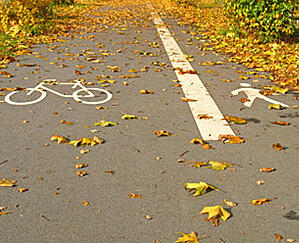 With the end of daylight savings time, having fun in the sun will be more challenging. During the week, our light must now be enjoyed from an office, factory, or school window. However, that doesn’t mean you can’t remain active outdoors.
With the end of daylight savings time, having fun in the sun will be more challenging. During the week, our light must now be enjoyed from an office, factory, or school window. However, that doesn’t mean you can’t remain active outdoors.
I remember riding my bike to work early in the morning when it was still dark. I was surprised at the number of pedestrians walking on our local biking/walking trail who weren’t wearing lights or reflective clothing. The pedestrians ranged in age from young schoolchildren to older adults. Fortunately, I had a very bright headlight, so I could see the pedestrians and adjust my speed and path accordingly. A lack of reflective clothing or lights puts pedestrians at risk.
In 2018, 6,283 pedestrians and 857 bicyclists were killed in crashes with motor vehicles.
Here are some safety tips to keep you and your family safe after dark.
1. Wear reflective clothing. Many kinds of reflective materials and clothing are available and vary in price. From vests and wristbands to reflective tape, all can help you remain visible when you’re outdoors after dark.
2. Buy basic reflectors for your kids. If your kids walk to school, buy inexpensive reflectors to attach to their backpacks. While this may not be cool, a reflector can significantly increase their chance of being seen. Also, consider buying reflective zipper tags.
3. Invest in a quality headlight and taillight. If you plan to ride your bike to work or for pleasure, make sure you have a quality headlight and taillight. You may purchase them individually or as a set, and they range in price. If you’re riding in the city where you’re aided by streetlights, a headlight with a flasher mode is essential. If you ride on a bike trail, the amount of lumens your headlight produces is critical. What’s a lumen? Simply put, the more lumens, the brighter the light.
When I bought my first light, I bought a set. The headlight was 22 lumens with a flash mode, high and low beams. The taillight had four LED lights that provided visibility up to 4,000 feet. I quickly learned that the headlight was great for city riding but wasn’t bright enough for riding on a dark bike trail. Therefore, based on a recommendation from a friend, I bought a headlight that produced 220 lumens. This light is suitable for dark trail riding.
4. Walk with a flashlight. Frequent injuries occur because of tripping or falling on uneven or cracked sidewalks. In addition, if you’re walking with a pet, a flashlight can help prevent your pet from stepping on a sharp object.
5. Light up your pet. Taking your dog for a nighttime walk isn’t just enjoyable; it’s often necessary. Collars and leashes that are reflective or light up are available. A light-up leash is excellent for walking after dark and encountering other pedestrians.
6. Resist wearing headphones. While the trend is to wear headphones while walking or running, it’s better if you don’t wear them. This will keep you more aware of your surroundings and help you sense danger.
7. Walk against traffic flow. If possible, always walk on the sidewalk; however, if a sidewalk isn’t available, walk against the traffic flow. This will help you see what’s coming toward you and will help you get out of the way if it appears you’re not visible to the driver. A bicyclist, on the other hand, should never go against the flow of traffic.
The links below share what’s available to keep you safe.
Reflective gear for you
Reflective gear for dogs
Do you have any suggestions or information you’d like to share? I'd love to hear from you. Please share them in the box below.
Sources:
http://www.safetyreflectors.com/index.html
http://www.pedbikeinfo.org/data/factsheet_crash.cfm
https://crashstats.nhtsa.dot.gov/Api/Public/ViewPublication/812826





